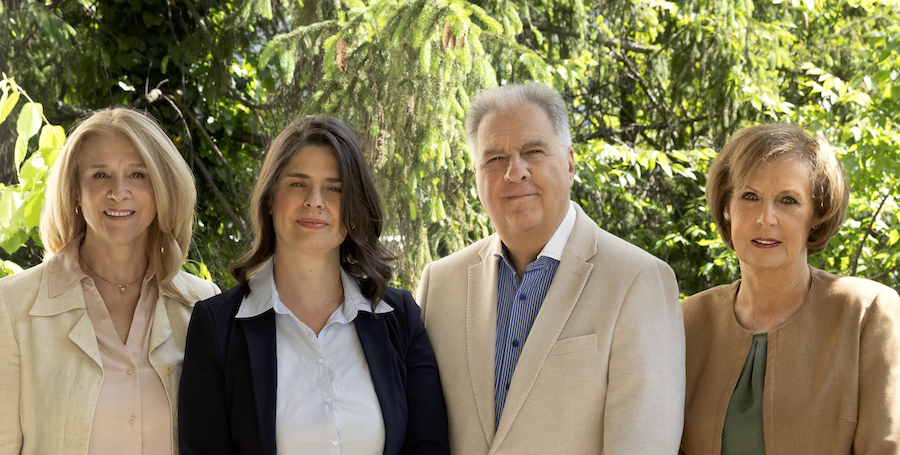'There has been an increased need for confidential searches - and this is our real expertise!'
Round table discussion with four Partners of Amrop Hungary

Nóra Ruszkai, Dr. Anett Andróczki, Richárd Kohlmann, Katalin Indra Hollai - Photo: Marianna Sárközy
- What makes a search ‘confidential’? Isn't every assignment like that?
- (Richárd Kohlmann:) A confidential search - or we can call it a 'silent search' - takes place when the client wants to fill a position without the knowledge of the employee(s) or the market, with minimal disclosure of information and the risk that anything can be revealed. Most of the time, quality replacement is in the background, but there are also cases when, for example, a stock exchange listed company does not want anything to leak out to the market prematurely.
- How can you search without the candidate knowing which company it is?
- (Anett Andróczki:) Well, it's not easy, but it can still work if the headhunting company is professional. This is our specialty, practically half of our assignments are confidential searches.
- Amrop has been present in Hungary for nearly 30 years, so I suspect that this also contributed strongly to the fact that companies turn to you with confidence for these kinds of more delicate searches.
- (RK:) It's true, this fact also plays an important role in our communications when we negotiate with clients regarding each assignment, but I have to say, it's not the only reason. "Word of mouth" works more and more in our profession, and also, well managed placements mean the greatest success, it brings customer satisfaction, and consequently more recommendations and eventually assignments.
- Are all the assignments completed successfully?
- (Nóra Ruszkai:) Roughly yes, I would say 99%.
- That's a fantastic ratio! I hear that recruitment companies approx. work on a 60-70% success rate…
- (NR:) Just to clarify: we are not a recruitment company! Executive search - or headhunting in an everyday word - does not recruit or advertise the positions, but - as the name implies – directly targets passive candidates by screening of individual profiles, i.e. those who sometimes have not even considered for switching. And our job is to convince them of that. This is a serious job, a profession, far fewer people do it well than they say about themselves.
- Whether an assignment is confidential or not, is there such a thing as an easier or more difficult search? Or do they all require roughly the same amount of effort?
- (Katalin Indra Hollai:) There are huge differences! In most cases, business as usual, however, there are also times when we almost have to look for a needle in a haystack, and clients often do not understand why they have to pay such a fee for this service. The good news is that we do find that particular needle…
- What is the headhunting market like now?
- (RK:) It's very good for us. Since 2021, we have been growing linearly, both in team size and sales revenue. We value every search, handle it precisely and with maximum care. We believe that we can't make mistakes, we can't blame the market situation or anyone else for anything and we have to fight until the perfect 'match' is made between client and candidate.

From Smart to Wise: What’s the difference, and why should it matter?
Smart decision making is critical to create and capture economic value. But it is unlikely to equip leaders and organizations to deal with today’s complexity, or ultimately earn legitimacy.
Wise decision-makers take specific measures to address business dilemmas in a holistic way. Not only do they create and capture economic value, they build more sustainable and legitimate organizations.
Focusing on factors over which leaders can exercise some control, our model includes a clear framework with practical tools, and addresses:
- Self Leadership: how leaders exercise self-governance
- Motivational Drivers: what drives leaders’ choices
- Hygienes: how leaders nourish their decision-making ‘health.’
In conclusion
The path to wise leadership is a never-ending process of self-reflection and learning. Our findings suggest that if most leaders are on the way, too many are submerged by daily business, cognitive overload and short-term imperatives. Too few are taking time for self-reflection, and miss the guiding frameworks that will enable them to step back and re-orient.
“Leaders are often very lonely when taking decisions,” one CEO told us. It is perhaps this isolation that is undermining wise decision-making – isolation not only from others, but from ourselves. The right stakeholders and engineering to transcend thinking traps are management essentials. Just as important are personal processes: feedback, coaching to identify true motivations, strengths, a Life Plan, and avenues for self-development. These are just some of the steps all leaders can take today – irrespective of age or seniority.
Where to start? Perhaps the journey begins in mindfulness, with one or two habitual and recognized reflective practices. These enable internal answers to emerge – also when it comes to which external support to seek, from whom, and why.
Downloads
Just the essentials - read the Executive Summary highlighting our key findings and takeaways.
Executive SummaryOur Full Report includes a question catalog and a Feedback Toolkit with 5 common feedback traps.
Full Report